Community Gardens & Greenspace
Natural Stormwater Solutions
The Conservancy believes greening communities with gardens, trees and other greening approaches are important components that add to the region’s quality of life. These approaches also help spur economic revitalization and combat pollution issues, such as reducing stormwater runoff in our waterways.
Stormwater runoff, and the pollution and sediment it brings, wreak havoc on our local rivers, streams and creeks. Fortunately, there are effective natural solutions to help manage stormwater runoff. Those solutions including tree plantings, bioswales, permeable pavement, rain gardens, riparian tree and shrub plantings and other native vegetative plantings near and along roadways, parking lots and sidewalks are collectively known as green infrastructure or natural stormwater management projects.
These green solutions use the living landscape to capture, store, absorb, filter and slow the flow of stormwater runoff at the surface – before it enters sewer systems and eventually local waterways. Green infrastructure projects can be alternatives and/or complements to traditional stormwater-collection methods, such as sewer pipes and drains. And often these greener options are less expensive than the traditional methods.
We offer municipalities a helping hand when they consider green infrastructure projects for their communities, assisting with planning and fundraising, project management during implementation and facilitation, community relations, volunteer engagement and expertise for the ongoing care of green infrastructure projects.
Bioswales
Filled with native plants, rocks and boulders, the bioswales are built and designed to store and slow the release of stormwater. With wide shallow depressions and slopes that are steep enough to prevent ponding, bioswales are gentle enough to encourage water filtering through plants and ground cover. Drains and piles of stones, known as rock weirs, are also built into the design. Not only are bioswales naturally attractive, they are also functional and effective stormwater management and filtration systems. Bioswales are often constructed near roadways and parking lots, and are viable alternatives to installing additional underground storm drains.
Bioswales are typically professionally designed and engineered facilities that are connected to existing sewer infrastructure, but use mostly natural elements like plants and rocks to help slow and manage stormwater runoff. Part of the design process undertaken by landscape architects and civil engineers includes surveying the slope of the land, calculating stormwater runoff volume, and infiltration testing to see how much water can be absorbed by the natural substrate. In cases where natural infiltration is low due to rock, clay, or other conditions, subsurface tanks can be used to retain runoff and slowly release the stormwater over a longer time period.

Point State Park Bioswale
As a gift as part of its centennial celebration, the Garden Club of Allegheny Club (GCAC) commissioned WPC to install an attractive bioswale and rain garden featuring native plants to help manage stormwater runoff in Point State Park.
The bioswale and rain garden was installed in 2015 at the base of the Fort Duquesne pedestrian bridge. Educational signage is available to the park’s 2 million annual visitors and provides information on the benefits and effectiveness of natural approaches like bioswales for managing stormwater.
The GCAC Centennial Celebration project partners included GCAC members, the Conservancy, Pennsylvania Department of Conservation & Natural Resources and the Penn State Master Gardeners of Allegheny County.
Centre and Herron Bioswale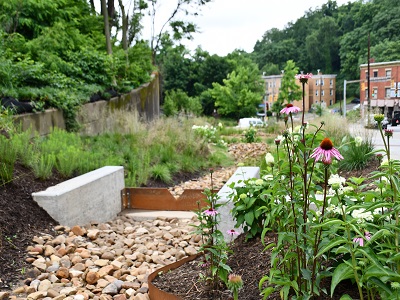
The Conservancy partnered with PWSA, ALCOSAN and the City of Pittsburgh to install the longest bioswale in Pennsylvania during 2018. The 535-foot bioswale at the intersection of Centre and Herron avenues in Pittsburgh’s Hill District neighborhood is designed to mimic a natural waterway and intercepts 882,800 gallons of stormwater from entering the combined sewer overflow through natural ground infiltration and absorption from plant material.
With the help of more than 250 community volunteers, WPC planted more than 13,000 perennial plants and 25 trees at the bioswale. In addition to maintaining the bioswale, WPC staff and volunteers continue to plant an annual flower garden at the site, which WPC has managed for more than 20 years. The bioswale received the 2018 Sustainability Award from the American Society of Civil Engineers.
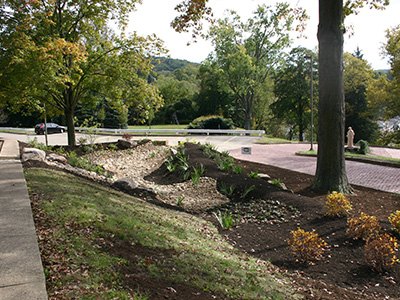 Millvale Bioswale
Millvale Bioswale
Located in a valley surrounded by hills and residential and commercial development, the Borough of Millvale has a long history of flooding. The borough is located within the Girty's Run watershed, which is affected by stormwater runoff that includes sediment like litter, auto fluids and pet waste.
In 2013, the Conservancy completed two bioswales on the property of the Sisters of St. Francis Mount Alvernia as part of Millvale's TreeVitalize Pittsburgh project to help reduce stormwater runoff. One of the bioswales, located along Hawthorne Road, is approximately 400 feet long. This bioswale intercepts water from an 11-acre tributary area, and according to monitoring data, the bioswales capture 89% of all rainfall during rainfall events. Another bioswale near a parking lot on the property is capturing water from a 1.2-acre area.
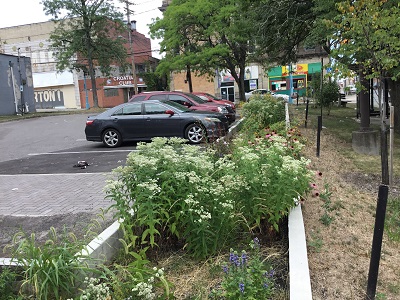 Clairton Bioswale
Clairton Bioswale
Residents of the City of Clairton learned about community forestry and green infrastructure while helping to manage stormwater and beautifying their community. A parking lot rain garden at the corner of St. Clair and Miller avenues in Clairton helps to control stormwater runoff. Designed and constructed by Merritt/Chase and Ethos Collaborative and funded by The Pittsburgh Foundation, the green infrastructure incorporated an existing catch basin and existing trees.
In 2019, 25 volunteers, including students from a local “learn and earn” program, helped plant 25 trees and 644 native perennials and grasses including butterfly milkweed, coneflower and Joe-pye weed to help absorb stormwater and filter pollutants. A bioswale and a permeable paver spot further slow the stormwater as it enters storm drains.
Bennetts Valley Senior Center, Weedville Rain Garden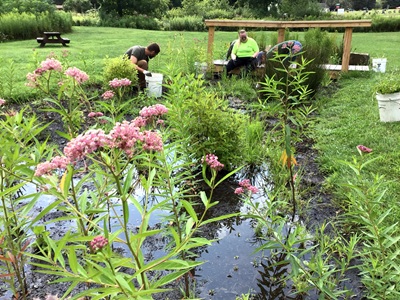
Thanks to the generous funding from The Stackpole-Hall Foundation, the Western Pennsylvania Conservancy worked with Bennetts Valley Senior Center, Elk County Conservation District and the Penn State Extension Master Gardener program to construct a rain garden on the BVSC property in 2023. This rain garden now offers a natural solution to flooding issues that occurred next to the senior center parking lot.
A variety of native perennials and shrubs, including cardinal flower, blue flag iris, swamp milkweed, common rush, liatris and buttonbush, help to absorb rain water. WPC built a small bridge over the rain garden to improve access to Kersey Run, a tributary to the Bennett Branch Sinnemahoning Creek, a popular fishing stream for local residents.
Marienville Library, Marienville Rain Garden
The Western Pennsylvania Conservancy partnered with the Friends of the Marienville Library to design, plant and maintain this rain garden next to the Marienville Library. Installed in 2018, the approximately 850-square-feet rain garden helps to receive stormwater runoff from the adjacent parking lot. Plants include false indigo, echinacea, bee balm, liatris and other natives. This project was financed in part by a Growing Greener grant from the Pennsylvania Department of Conservation and Natural Resources administered by the Northwest Commission.
Lincoln and Frankstown Rain Garden
The Conservancy partnered with Lincoln Elementary School (Pittsburgh Public Schools) and Pittsburgh Community Services to transform an existing community flower garden in Pittsburgh’s Larimer neighborhood into a rain garden. Located at Lincoln and Frankstown avenues, the rain garden is planted with native perennial plants that will help mitigate stormwater from 1.5” storm events: nine redbud, serviceberry and American hophornbeam trees, and 262 native plants, including black-eyed Susan, iris, coneflower, sneezeweed, beardtongue and more.
The installation including moving earth to create steep slopes and a wide basin and building curb cuts. Half of the existing garden is on a vacant city lot and half is on PPS property at Lincoln Elementary School, providing an excellent opportunity for the rain garden to be used as an outdoor classroom to teach young urban students about pollinators, green infrastructure, the effects of stormwater on our water system and more.
 Harrison Rain Garden
Harrison Rain Garden
Harrison Township Residents wanted to improve their urban forest and decrease stormwater runoff. The lawn of Highlands Middle School is the site of a beautiful rain garden that helps to manage stormwater runoff, thanks to 28 community volunteers. They worked with the Conservancy in 2019 to plant trees such as witchhazel, serviceberry, and dogwood and wetland plants native to Western Pennsylvania such as cardinal flower, iris and goldenrod. The rain garden, designed and constructed by Merritt/Chase and Ethos Collaborative, incorporated an existing catch basin and trees and includes a gravel path and a seating area with educational signage.
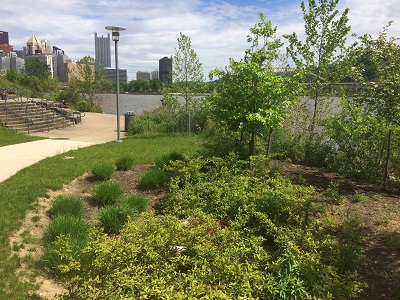 Carnegie Science Center Rain Gardens
Carnegie Science Center Rain Gardens
Two rain gardens installed at the Carnegie Science Center in Pittsburgh help to reduce and capture pollutants from entering the Allegheny River, provide wildlife habitat and provide educational activities. The upper rain garden is designed to catch water off of the building and allow it to slowly filtrate back into the water table. Native trees and plants in the lower rain garden help prevent erosion and stormwater runoff from entering the river. In 2018, 68 volunteers helped to plant 274 shrubs including boxwood, hummingbird summersweet, and inkberry; 557 grasses, including liriope and switch grass; 440 perennials including aster, coneflower, and cardinal flower and 49 trees including redbuds, London planetrees, serviceberries, white pines, dogwoods and magnolias.
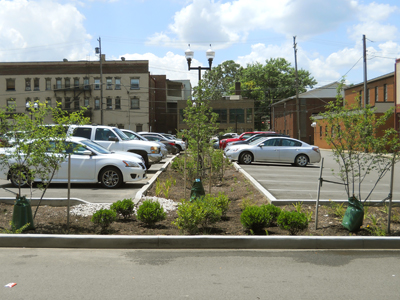 Carnegie’s Green Parking Lots
Carnegie’s Green Parking Lots
The Borough of Carnegie is prone to flooding due in part to its location within the lower Chartiers Creek watershed. So, Carnegie partnered with the Conservancy in 2016 to design, create and plant two new green parking lots in the heart of the central business district. Using a loan from PennVEST, the green parking lots included the installation of trees, bioswales, and native perennial shrubs and flowers. Together with the permeable pavement for the lots, these green features are capturing stormwater and slowly releasing it into the borough’s storm drains.
The project created about 10,400 square feet of porous surfaces, including the lots and surrounding vegetation. Planted by community volunteers, these green parking lots are examples of the type of natural greening solutions the Conservancy implements to help manage stormwater runoff. We take a collaborative approach to this type of work – partnering with community residents and leaders, and business owners – and foster similar partnerships for greening project across communities.
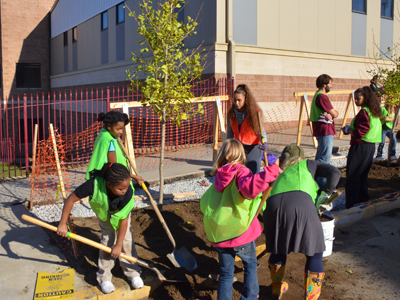 Tree Trenches at Barrett Elementary School
Tree Trenches at Barrett Elementary School
Walking along East 12th Avenue in Homestead Borough, one might not think twice about the six gingko trees near Barrett Elementary School. They’re not just your average trees. These trees, planted by students and teachers in 2016, are part of a larger effort to manage stormwater runoff in the borough through the use of natural green infrastructure.
The school is located on a hillside proliferated by concrete and asphalt, and sits in the direct path of rushing rainwater during rainfalls. This water travels into the business district a few blocks below and eventually into the borough’s combined sewer system, often causing overflows of raw sewage into the Monongahela River during even the smallest rainfall. The tree trenches now help slow and capture this stormwater from the hillside before it reaches the business district.
Tree trenches, also known as infiltration beds, absorb stormwater using a system of soil, trees, native vegetation and rocks strategically connected by underground stormwater drainage. While the trench captures and slowly releases stormwater to prevent overflows, roots from the trees absorb some of the rainwater within the trench. The trees will eventually release the rainwater as evaporation into the air.
With grants from the PNC Charitable Trusts and Allegheny County Conservation District, the Conservancy worked in partnership with Barrett Elementary School, Steel Valley School District and Homestead Borough to create and install these tree trenches and plant the trees. At more than 68 feet long, the tree trench in the school’s sidewalk is designed to capture and divert up to 4,400 gallons per storm event from entering the sewer system.
For More Information:
Alicia Wehrle
Community Greening Project Manager
Western Pennsylvania Conservancy
800 Waterfront Drive
Pittsburgh, PA 15222
